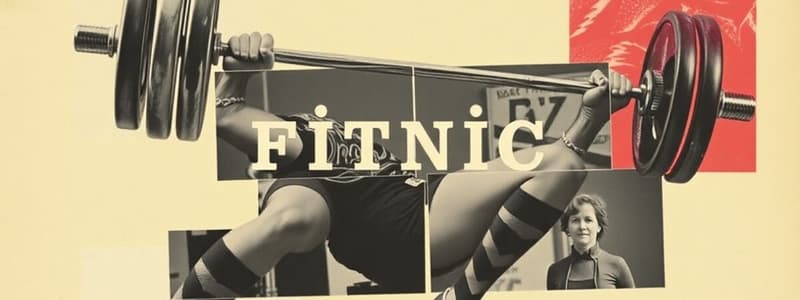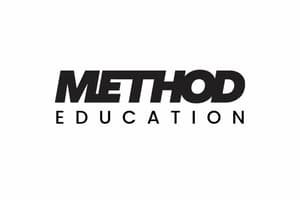Podcast
Questions and Answers
What does the term 'training max (1RM)' refer to in weightlifting?
What does the term 'training max (1RM)' refer to in weightlifting?
- The minimum weight required for effective training
- The maximum amount of weight that can be lifted for a single repetition (correct)
- The average weight lifted across all sets
- The maximum weight one can lift for multiple repetitions
Which of the following statements about warm-up and cool-down exercises is accurate?
Which of the following statements about warm-up and cool-down exercises is accurate?
- Cool-down exercises are optional after every workout
- Warm-up exercises should be avoided before lifting heavy weights
- Cool-down exercises are meant to increase muscle fatigue
- Warm-up exercises prepare muscles and joints for the workout (correct)
What is the primary characteristic of compound lifts?
What is the primary characteristic of compound lifts?
- They involve multiple muscle groups in the exercise (correct)
- They primarily isolate a single muscle group
- They are always performed with lighter weights
- They require no equipment
What does the term 'tempo' refer to in the context of weightlifting?
What does the term 'tempo' refer to in the context of weightlifting?
Which of the following best defines 'failure' in a weightlifting context?
Which of the following best defines 'failure' in a weightlifting context?
What is the primary purpose of accessory exercises in a weightlifting routine?
What is the primary purpose of accessory exercises in a weightlifting routine?
How is a 'set' defined in weightlifting terminology?
How is a 'set' defined in weightlifting terminology?
Which of the following statements about 'form' in weightlifting is correct?
Which of the following statements about 'form' in weightlifting is correct?
Which training technique involves taking breaks between sets to maximize muscle fatigue?
Which training technique involves taking breaks between sets to maximize muscle fatigue?
What is the term for the increase in muscle size resulting from resistance training?
What is the term for the increase in muscle size resulting from resistance training?
Which of the following best describes the concept of progressive overload?
Which of the following best describes the concept of progressive overload?
In the context of weightlifting, what does volume represent?
In the context of weightlifting, what does volume represent?
Which modification is aimed at isolating muscle groups more effectively?
Which modification is aimed at isolating muscle groups more effectively?
What is crucial to prevent injury before starting a workout?
What is crucial to prevent injury before starting a workout?
Why is it important to consider an individual's experience level when modifying exercises?
Why is it important to consider an individual's experience level when modifying exercises?
Which principle refers to the systematic variation of training parameters over time?
Which principle refers to the systematic variation of training parameters over time?
What is the primary role of a spotter during weightlifting?
What is the primary role of a spotter during weightlifting?
How does progressive overload contribute to muscle strength?
How does progressive overload contribute to muscle strength?
What is the purpose of warming up before weightlifting?
What is the purpose of warming up before weightlifting?
Which type of exercise targets multiple muscle groups simultaneously?
Which type of exercise targets multiple muscle groups simultaneously?
What does 'tempo' refer to in weightlifting?
What does 'tempo' refer to in weightlifting?
What is the primary focus of powerlifting compared to Olympic weightlifting?
What is the primary focus of powerlifting compared to Olympic weightlifting?
Which piece of equipment is specifically designed to provide stability during heavy lifting?
Which piece of equipment is specifically designed to provide stability during heavy lifting?
What does a warm-up primarily aim to do before weightlifting?
What does a warm-up primarily aim to do before weightlifting?
Which of the following exercises is classified as a compound exercise?
Which of the following exercises is classified as a compound exercise?
Which exercise is characterized by lifting the barbell from the floor to overhead in two distinct movements?
Which exercise is characterized by lifting the barbell from the floor to overhead in two distinct movements?
What does the term 'proper form' refer to in weightlifting?
What does the term 'proper form' refer to in weightlifting?
Which of the following best defines a rep (repetition) in weightlifting?
Which of the following best defines a rep (repetition) in weightlifting?
Which statement regarding the range of motion (ROM) is true?
Which statement regarding the range of motion (ROM) is true?
Flashcards
Lift
Lift
The general term for any exercise that involves lifting weights.
Rep
Rep
A single complete execution of a lift, like lifting a barbell once and lowering it back down.
Set
Set
A group of repetitions performed consecutively with a specific weight.
One Rep Max (1RM)
One Rep Max (1RM)
Signup and view all the flashcards
Weight
Weight
Signup and view all the flashcards
Form
Form
Signup and view all the flashcards
Compound lifts
Compound lifts
Signup and view all the flashcards
Isolation lifts
Isolation lifts
Signup and view all the flashcards
Rest-pause
Rest-pause
Signup and view all the flashcards
Negative reps
Negative reps
Signup and view all the flashcards
Progressive overload
Progressive overload
Signup and view all the flashcards
Hypertrophy
Hypertrophy
Signup and view all the flashcards
Strength
Strength
Signup and view all the flashcards
Power
Power
Signup and view all the flashcards
Intensity
Intensity
Signup and view all the flashcards
Volume
Volume
Signup and view all the flashcards
Compound Exercises
Compound Exercises
Signup and view all the flashcards
Isolation Exercises
Isolation Exercises
Signup and view all the flashcards
Weight Plates
Weight Plates
Signup and view all the flashcards
Lifting Belt
Lifting Belt
Signup and view all the flashcards
Proper Form
Proper Form
Signup and view all the flashcards
Range of Motion (ROM)
Range of Motion (ROM)
Signup and view all the flashcards
Maximal Strength
Maximal Strength
Signup and view all the flashcards
Breathing Techniques
Breathing Techniques
Signup and view all the flashcards
Compound Movements
Compound Movements
Signup and view all the flashcards
Study Notes
Basic Weightlifting Terms
- Lift: The general term for a weightlifting movement or exercise.
- Rep: Short for repetition. A single complete execution of a lift.
- Set: A group of repetitions performed consecutively with a specific weight.
- Warm-up: Exercise before a workout to prepare muscles and joints.
- Cool-down: Exercise after a workout to reduce muscle soreness and improve flexibility.
- Rest period: Time between sets to allow for muscle recovery.
- Training Max (1RM): The maximum amount of weight an individual can lift for a single repetition. This is a crucial benchmark for determining appropriate weights for training.
- Weight: The amount of mass being lifted, expressed in standardized units like kilograms (kg) or pounds (lbs).
- Form: The technique and posture used during a lift. Proper form is critical for maximizing performance and minimizing injury risk.
- Progression: The process of gradually increasing weight, reps, or sets over time to improve strength and fitness.
- Accessory exercises: Exercises that support the primary lifts by targeting specific muscle groups or improving foundational movements. Examples include shrugs, rows, and overhead presses.
- Deadlift: A compound exercise that involves lifting a barbell from the ground to a standing position.
- Squat: A compound exercise that involves lowering the body into a squatting position with weight on the back.
- Bench Press: A compound exercise where a barbell is pushed up and down while lying flat on a bench.
- Overhead Press: A compound exercise that involves pressing a weighted barbell or dumbbells overhead.
- Pull-ups: A bodyweight exercise for pulling oneself up and down on a bar.
- Dips: A bodyweight exercise for pushing oneself up and down on parallel bars or supports.
- Barbell: A metal bar with weight plates attached, used in barbell exercises.
- Olympic Weightlifting: A sport encompassing lifts like the snatch and clean & jerk. It focuses on explosive power and speed.
- Powerlifting: A sport centered on maximum strength in the squat, bench press, and deadlift. Focuses on maximal force.
- Weightlifting: The general term for exercises using weights to build strength and muscle. Broad category encompassing both Olympic and Powerlifting.
Weightlifting Equipment
- Weight Plates: Metal disks added to a barbell to increase resistance.
- Barbell: A metal rod used to support weight plates.
- Weightlifting Shoes: Often have a flared heel and special lifting soles for support in different types of lifts.
- Lifting Belt: A supportive belt worn around the waist to stabilize the core during heavy lifting.
Exercise Types
- Squat: A compound exercise that focuses on the quadriceps, hamstrings, and glutes.
- Bench Press: A pressing exercise performed lying on a bench, targeting the chest, shoulders, and triceps.
- Deadlift: A compound exercise that works multiple muscles of the back and legs, including but not limited to the hamstrings, glutes, traps, lower back, and forearms.
- Clean & Jerk: An Olympic lifting exercise characterized by lifting the barbell from the floor to overhead in two movements.
- Snatch: An Olympic weightlifting exercise that moves the barbell from the floor to overhead in one continuous movement.
- Overhead Press: A pressing exercise that raises the weight to shoulder level and then overhead.
- Pull-ups: A bodyweight exercise targeting the back, biceps and forearms.
- Dip: A bodyweight exercise targeting chest, triceps, and shoulders.
Lifting Technique and Form
- Proper Form: Maintaining correct posture and movement throughout the exercise to prevent injuries and ensure maximum effectiveness.
- Range of Motion (ROM): The full extent of movement possible at a joint. Proper exercises use full ROM.
- Spotter: A person aiding in safely performing lifts, preventing potential injury in case of a lift failure.
- Tempo: A planned rate and rhythm of lifting, lowering, and pausing, often used to aid in muscle growth and proper form.
- Breathing Techniques: Incorporate controlled breathing throughout the lift for stabilization and power.
Weightlifting Terminology
- Maximal Strength: The greatest amount of force a muscle or group of muscles can exert. Key in Powerlifting exercises.
- 1 Rep Max (1RM): The maximum weight lifted for a single repetition.
- Progressive Overload: Gradually increasing weight, sets, or reps over time to continually challenge muscles and promote strength gains.
- Compound Movements: Exercises targeting multiple muscle groups simultaneously (squats, deadlifts, bench press).
- Isolation Exercises: Exercises targeting a single muscle or muscle group (bicep curls).
- Eccentric Contraction: The lengthening of a muscle during an exercise, often a portion of a lift. (Lowering the weight)
- Concentric Contraction: The shortening of a muscle during an exercise, often used in the lifting phase. (Pulling up weight)
Weightlifting Training Programs
- Training Splits: Dividing training sessions to target different muscle groups on different days.
- Periodization: Structuring training programs with varying intensities and volumes over time.
- Hypertrophy: Building muscle mass and size. Weightlifting is key in this.
- Strength Training: Building and increasing strength in muscles and muscle groups.
Safety Considerations
- Proper Warm-up: Crucial for injury prevention.
- Weight selection: Choosing appropriate weights to maintain good form is essential.
- Spotters: Use spotters when necessary, especially for heavy compound lifts.
- Form: Maintaining proper form throughout the lift to minimize injury risk.
- Rest and Recovery: Appropriate rest and sleep are important for repairing muscles.
- Listen to your body: Stop and seek help if you feel any pain.
- Proper technique: Ensuring correct posture and movements to avoid straining muscles or joints.
- Consider experience level: Modifying exercises for beginners to avoid injury.
- Warm-up and Cool-down: Crucial for injury prevention.
- Proper Form: Fundamental to avoid injury.
- Spotters: Safe practice using a spotter for heavier lifts.
- Lifting Belt: Provides lumbar support and stability.
- Listen to Body: Understanding muscle and body limitations is crucial to a safe program.
Studying That Suits You
Use AI to generate personalized quizzes and flashcards to suit your learning preferences.




